

Johannes Vermeer is best known for his paintings of serene domestic scenes, like “The Milkmaid” and “Girl with a Pearl Earring.” The paintings are excellent examples of the delicacy and beauty of the Dutch realist style. Vermeer’s style is defined by his use of light and shadows to create a more perfect world than what he saw in reality. He used expensive pigment lapis lazuli to add depth and richness to his paintings. Vermeer’s subjects offer a glimpse into 17th-century Dutch society, from the everyday life of a milkmaid to the luxury of the rich. His use of light and shadows helped to create a more realistic and believable world for his viewers.

His painting, “Woman Reading a Letter,” is another iconic example of his work and demonstrates how Vermeer could create a breathtaking composition and a compelling narrative.
 The painting shows a woman, dimmed by shadows, standing and reading a letter. The woman’s blue top is a beddejak, typically made of blue or white satin, and worn while in bed, giving the impression that perhaps she’s just woken up. An unseen window to the left casts soft light on her visage. We cannot see the letter’s contents, and there are few clues about its significance. The room is nearly bare.
The painting shows a woman, dimmed by shadows, standing and reading a letter. The woman’s blue top is a beddejak, typically made of blue or white satin, and worn while in bed, giving the impression that perhaps she’s just woken up. An unseen window to the left casts soft light on her visage. We cannot see the letter’s contents, and there are few clues about its significance. The room is nearly bare.
The painting is renowned for its mystery. What is the woman reading? What is the letter about? Why is she wearing a beddejak? Is she pregnant? These are all questions that have been debated by scholars for centuries.
One interesting detail in the painting is the large, muted wall map of Holland in the upper right of the composition. Some have suggested that it may allude to the author of a letter, perhaps a husband away on a journey, or an absent lover (the pearls on the table could allude to vanity). But the map might have more practical implications. Decorative wall maps were a popular fixture of Dutch interiors during the 17th century. Most often, in paintings, they were included simply to add some compositional drama to otherwise empty walls. Vermeer’s inclusion of the map, and the way he has muted its colors so that it is nearly the same color as the woman’s head, suggests that the map reflects her quickly racing thoughts and emotions.

Though Vermeer’s paintings may look like snapshots taken from daily life, his compositions were anything but unplanned. He often borrowed motifs from the works of his contemporaries, such as Gerard ter Borch. And he was known for his attention to detail, particularly regarding the effects of light and perspective. Some scholars believe that he worked with the aid of a camera obscura.
Vermeer was born in Delft in 1632, the son of a prosperous silk merchant, and apprenticed as a painter. He joined the Guild of Saint Luke in 1653 and married Catharina Bolenes that same year.
Vermeer worked slowly and with great care and frequently used very expensive pigments. He is particularly renowned for his masterly treatment and use of light in his work.
Most of Vermeer’s paintings depict domestic scenes set in two smallish rooms in his house in Delft. His subjects are mostly women engaged in everyday tasks such as reading, sewing, or cooking.
Vermeer’s modest celebrity gave way to obscurity after his death in 1675. He was barely mentioned in Arnold Houbraken’s major source book on 17th-century Dutch painting (Grand Theatre of Dutch Painters and Women Artists) and was thus omitted from subsequent surveys of Dutch art for nearly two centuries. In the 19th century, Vermeer was rediscovered by Gustav Friedrich Waagen and Théophile Thoré-Bürger. They published an essay attributing 66 works to him, although only 34 paintings are universally attributed to him today.
Read more: https://news.artnet.com/art-world/vermeer-woman-reading-letter-three-things-to-know-1902900
https://en.wikipedia.org/wiki/Johannes_Vermeer
Are you a fan of Vermeer’s work? What do you see when you look at “Woman Reading a Letter? Have you created art that is open to interpretation?
